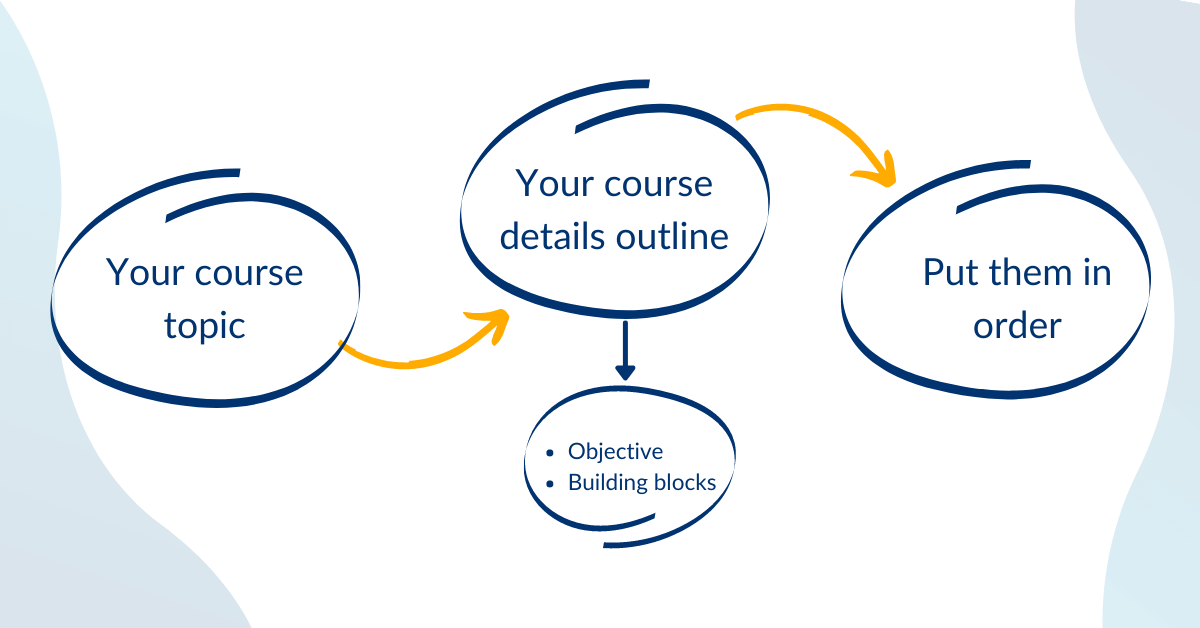You must have surely thought about it. Creating an online course. The market for online learning is massive. Estimated in the tens of billions of dollars globally, and rising steadily at around 10% annually. Traditional educators have of course adopted online learning platforms, but more and more ‘financially accessible’ options are now available that are hugely popular. On demand, topic specific courses allow users to skill up quickly, affordably and on their terms.
Okay you must be thinking. How do I even begin? What course should I offer? Where will it be located?
I am sure these are just some of the questions that you may have but don’t worry, we’ll guide you step by step
The online course is now as essential to any entrepreneur, expert or thought leader’s toolbox, as a website and business card.
One of the fastest and most impactful ways to get your knowledge out to a global marketplace, making a bigger impact and making more money, is to download that knowledge lying dormant in your brain and turn it into a lead-generating, money-making, impact-creating online course.
1. Do basic research to test your assumptions
Certainly the biggest failure in my early online course launches was not doing enough research. Let’s be honest – not doing any research whatsoever. Doing basic research will test your assumptions, save you weeks of frustration, and likely save you a bucket full of money.
Here’s how simple it can be by following these steps:
a. Send out a survey to your ideal client
The fastest way to test your market is with a simple two question survey. Sure, you can spend a couple of weeks designing and testing a 20-question survey that breaks out the psychographic and buyer preferences of your list, but unless you have a pretty large list and know how to wade through all that data, simple is better.

A few steps to follow are:
- Identifying your customers’ pain,
- What they think is a perfect solution and
- The language they use to describe their pain.
- Later, in the sales process, when it comes time to communicate the value of your new course, you’ll want to use the language of your prospects.
For example, the survey results might give you gems like: ‘frustrated’, ’fighting an up-hill battle’, or ‘desperate to find a better solution’ – that’s the kind of language you can use when marketing your course. More on that later.
The two questions for your survey are:
When it comes to [the area you are an expert in] what is your biggest challenge?
Thinking about that challenge, what would be an ideal solution?
Of course, you’ll preface your survey with the reason you’ve come calling and that responses will be kept anonymous.
b. Get your potential clients on the phone
Do you remember the times where you actually picked up the phone and talked to someone? *Gasp*.
This doesn’t have to be scary – after all, I’m sure you’d be happy to speak with them if they bought your course, so why not speak with them before they make their decision?
A 15 minute phone conversation can return gems. You get to learn about their challenges, test content and you can even test your pricing.
This part of your research doesn’t have to be hard.
Set your sights on 10 calls, book 2 per day, and you’re done in a week. Remember to finish the call by asking if you can follow up once the course is ready.
When you do this, it is a good idea to send out a request for a call by email. Once I get confirmation, I avoid a lot of annoying back-and-forth about time and dates by sending a link to my calendar booking tool.
c. Research your competitors
Another thing that most people fail to do is look at what the competition is doing. Because let’s face it, there’s other solutions out there. Your job is to find the online solutions already selling and study them.
Some of the elements to look at include:
- What’s the main benefit they promise?
- What deliverables do they promise?
- What’s their price point? Do they offer discounts?
- Do they provide live support?
- Is there a guarantee?
- How many modules are there and how long are they?
You don’t have to compete on every element of their design, but your price/value combination (what I get for my money) should be competitive and you do need some competitive advantage (which could be your reputation).
2. Steps to creating an online course
Now that you have done your research it is time to create an online course. I am sure you
are wondering where to start. Do not worry. Just follow these simple steps:

a. Select a course topic based on your research
One of the most important aspects of how to create an online course is leading with specificity and focus. Your clients should have a very clear notion at the outset of what it is you aim to teach, and how to plan to do so.
Think of this process as your way of branding your online course. What does it offer potential customers? How will it change their lives? And what makes your content different, better, and more actionable than everyone else’s?
Topic and direction can influence your success right out of the gate.
Your course topic should reflect the specific focus of your course content. The direction should describe how you intend to reinforce the theme through your content.
Your direction sets the tone for how you’ll create an online course specifically for the audience and topic you’ve landed on. You can get into more detail with your direction.The more detail you use, the sharper your vision becomes.
This strategy works for any type of online course you might want to create.
b. Outline your course details
A course outline is an invaluable tool to help you deliver on the solutions you promised to your clients. Not sure where to start? Let’s break it down.
c. What Is Your Destination?
The best place to begin is at the end. To build a strong course outline, decide on your end goal and work backwards from there.
What is the objective of your course and what should your clients be able to do by the end?
Finally, what skills and knowledge must you impart to get your students to their final destination?
d. Determine Your Steps
When considering these questions, make a list and keep it simple.
Start with the most basic foundation you expect your clients should have, and build up from there. Think of these skills like building blocks: you’ve got to stack them one on top of the other to build a solid structure.
Consider starting with an orientation chapter where you introduce everyone to the vocabulary and baseline content you’ll use for the rest of the course.
This is helpful for expectation-setting and giving your clients a view of the roadmap to come, but it’s also an excellent way of making sure everyone starts off on the same foot. You never know when a client joins your course if they’re familiar with the jargon and shorthand you use on a daily basis; this orientation module is an opportunity to make sure everyone knows the same things and starts the course with the same set of ideas.
e. Once you’ve figured out what building blocks you need, it’s time to put them in order.
They will form your course modules or chapters (or whatever you choose to name them!). Organize your steps sequentially, with each one building on the next. This means you should place your easiest content in Module 1, build on it in Module 2, and so on. If possible, you should have some overlap between modules to help students contextualize the information by creating connections to what they learned in the previous section.
Add learning points and exercises
Build your slide decks
Build your slide decks
3. Select a platform for your course
a. Research different course platforms
When you’re ready to get your knowledge out to the world with an online course, you have many decisions to make! An important one is which platform you’ll use. The platform houses your course content. The right platform can make or break your course. When choosing a platform, look for a solution that offers the following features:
- Diverse design options: A poorly designed course can quickly turn off customers, especially if it’s not easy to navigate or understand.
- Built-in marketing: You can’t earn money until prospects find out about your course. A platform with built-in landing pages, email marketing templates, and other features can cut your workload in half.
- Many content options: E-learning courses don’t always involve text-only modules—in fact, the best ones often feature visuals and interactive elements to enhance the learning experience. You could add a video, podcast, or other formats to your course. If your platform doesn’t support those mediums, however, you’re out of luck
- Flexibility: Will you release every part of your course at the same time? Do you plan to slowly drip courses into your customers’ accounts? Flexibility can help you design a course that fits the content.
b. Best Online Course Platforms to Create and Sell Online Courses
Once when you have done your research on the functionalities that you want your software to have, you can look at some of the existing platforms available to make your choice.

When selecting a platform you should be mindful of the different categories of online course platforms and select the one that fits your business the best:
- Standalone Course Platforms (Great for solo edupreneurs, small businesses)
- All-In-One Course Platforms (Run your Web site and course site together)
- WordPress Course Options (For those who want to keep it all in WordPress)
- Marketplace Course Platforms (Get a pre-made market to sell courses online)
- Video Course Platforms (If your main focus is on selling videos)
- Small Business-Extended Enterprise (For more complex needs, selling business-to-business)
- Moodle Plug-Ins/Add-Ons (Make Moodle into a selling machine)
A good place to start looking at some differences is at Learning Evolution – The 15+ Best Online Course Platforms to Create and Sell Online Courses. Read more about it here.
4. Set rates for your online course:
The price of your course has a direct impact on virtually every aspect of your online teaching business – from the type of marketing you can do to promote your course, to the type of students your course attracts, the amount of support and attention you can provide to your students, and of course, the amount of revenue you can generate from your course sales.
Let’s take an example here. Let’s say that you created a course and you have these things on your mind before you make up with a price:
- I’ve spent 6 months developing it. Plus, I had to buy a camera and a green screen to record it. So, I’ll calculate all the costs and set the price that covers them or maybe a little higher.
- I’ll look for similar courses, see how much my competitors charge, and set a price that is around the average numbers.
- I’ll try to estimate how my course can benefit my learners and price it at a tangible value.
While all the options have the right to exist, the correct answer is the third one. Unlike traditional physical products, the results of intellectual work are way more difficult to evaluate, so it’s tempting to go with hours spent on production or equipment bought as pricing components. It’s a dead-end road.
When it comes to online courses, it’s better to come from a hypothesis that the people who the course benefits will readily pay a certain sum for this value. But which sum? Well, there’s no universal golden rule for that, so to some extent, it’s a bit like playing a guessing game.
5. Market your course online
a. Create and optimize your website
These days, it’s essential to have a website—especially since your entire product is online. Your website helps you funnel traffic toward your online course and is likely the first thing people will search for when they hear of you.
Since you’re planning on marketing and selling online courses, your website should establish your authority right away. On your homepage a good idea would be to include a photograph of yourself, testimonials from people who have witnessed your work or your skill, and information about why you’re qualified to teach your courses.
You should also keep it short but use compelling action words and specific adjectives to get your point across.
A website should include other pages, as well, including:
- About page: Go into more detail about how you can help your audience reach their goals or solve their problems. Don’t make it all about you. One of the most important lessons of learning how to market an online course is balancing how to make your target audience feel cared for while also promoting your product
- Contact page: Make sure prospective customers can get in touch. If possible, offer multiple methods of reaching you, such as a contact form, an email address, and your social media pages
- Sales page: A sales page lists all of your products along with brief descriptions. Each product name should link to an individual product page. It’s important to get your sales pages right; think of them as the online equivalent of an elevator pitch. You get just a few seconds to snag your audience’s attention and to convince them they want more
- Product pages: You’ll need a product page for every online course you offer. Eventually, you can also use product pages to offer course bundles
As you continue learning how to market your online course, you’ll find that A/B testing goes a long way in optimizing these crucial pages. You might find that a simple copy change or additional CTA increases your conversions two-fold.
b. Promote organically with social media
Speaking of social media, it’s time to get busy on this front, as it’s become one of the top ways to market an online course (or any product, for that matter). Set up accounts with two or three of the main social platforms and use them to build and engage with your target audience.
We’ll analyze Twitter, Facebook and Youtube to guide you on what steps to take.

Facebook:
Marketers can use Facebook to promote their blog posts, engage in conversations with their followers, and share interesting links with their audiences. It’s the ideal social media platform for hosting giveaways and other special events, finding influencers, and gaining insight into your audience. Consider setting up a Facebook business page for your online courses.
Features like Facebook Stories and Facebook Live give you an opportunity to add personality and authenticity to your marketing strategy by connecting personally with your audience (you can even engage in live Q&A sessions on your course). Once you know the basics of how to market an online course on Facebook, you can start to grow a self-sufficient community of followers who share your product with their friends. Sounds cool right?
Twitter:
Think of Twitter as blogging lite. You only get 140 characters to share a message, so you have to pare down your words to the most meaningful ones. Twitter works well to market your online course if you want to build a massive audience while engaging with other people who share your passions and interests.
YouTube:
If you’re willing to stand in front of a video camera, YouTube can provide significant visibility, especially if you’re comfortable speaking about your topic. Use YouTube to share brief videos that answer single, important questions related to your online courses, or even to embed longer-form content directly onto your website, such as interviews with other experts in your field.
c. Host a live Webinar:
If you’ve ever imagined yourself on live television, you can turn your dream into a reality. Live webinars put you in the spotlight while your audience watches live from their corner of the world. You can also record webinars to create evergreen content; people can tune in later if they missed out on the live feed.
Webinars allow you to connect with your target audience in a way that television does not. Participants can interact with you by asking questions, submitting feedback, and otherwise giving their comments.
d. Create an affiliate program
One of the best ways to spread the word about your products is to have your partners help do the marketing for you. An affiliate may know how to market your online course in an exciting new way because of their own internal resources and unique perspective.
A good idea if you want people to evangelize your product, give them a financial incentive to do so. Affiliate programs work in three simple steps:
- Give each affiliate a unique code.
- Record each person who buys your course using the code.
- Give the affiliate the agreed percentage of the sale.
e. Invest in paid online ads
Sometimes, you have to make an investment in order to make money. Online advertising puts your content in front of your potential clients which often can lead to a sales increment. Ads like paid search, paid social, and display ads can all work in your favor, and provide you a direct line to your target audience.
Some of the most common types of ads follow:
- Google Ads (formerly Google Adwords): If you sign up for Google Ads, you can create a paid search program. Your ads will appear when people search for the keywords on which you bid.
- Facebook Ads: Set up Facebook ads so that your content appears on people’s news feeds.
- YouTube Ads: The same goes for YouTube. The company offers pre-roll ads as well as ads that appear in the middle or at the end of videos.
You can either join an advertising program or set up your online ads by yourself. If you’re a complete beginner, there are plenty of resources on the web that can teach you how to market your online course using specific paid advertising platforms.
This concludes the instruction on how to create an online course. What is your opinion on the steps? Have you ever thought of any of these steps? Have you ever tried them? If so, how did it work out?
Let us know in the comments below in feel free to reach out to me with any questions through our website.






0 Comments